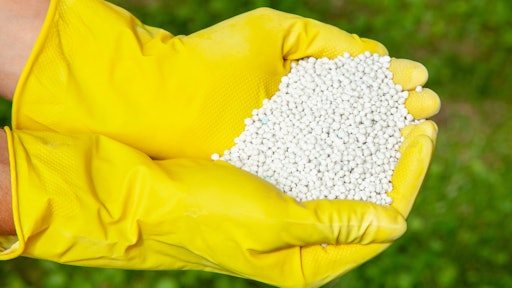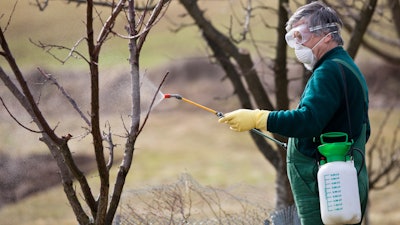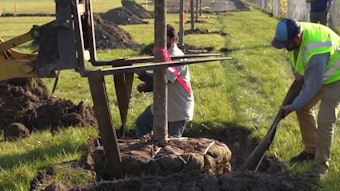
Landscaping crew members often work with chemicals, especially if the company is actively involved in lawn care using fertilizers, weed killers, and various pesticides that can often be considered hazardous.
Such chemicals can get on your skin, in your eyes or enter your body through inhalation, or be transported from your hands or the treated lawn to your mouth. The insecticides, herbicides and fungicides used by lawn care providers can be harmful if not handled properly. It is imperative to protect both your crew members and anyone else on the property from such hazards.
First and foremost, one of the most critical components is proper employee training. Adequate training should always include correct application methods as well as the following safety tips listed below. All new employees require company-specific safety training, and refresher courses help all employees, regardless of their skill level or time employed.
Here are few safety tips to keep your company safe when dealing with lawn care chemicals:
Maintain Safety Data Sheets (SDS)
A copy of current safety data sheets -- previously known as safety data sheets SDS -- is required in the workplace for any hazardous chemicals used by employees on the job site or around the shop. Safety data sheets align with the United Nation’s Globally Harmonized System of Classification and Labelling of Chemicals (GHS) and provide information on the safe use, handling, and storage of hazardous chemicals. Obtain SDSs through the chemical manufacturer; store them as a paper or electronic copy.
Follow Labeled Directions
Every chemical product used in the landscaping industry has explicit instructions on the label for mixing/diluting the product and an application protocol. The label will include information on application, first-aid information, personal protective equipment requirements/recommendations and storage and disposal. Always follow label directions closely, never mixing the product stronger than recommended, or applying at a higher rate. This is one of those time where it is important to take the time to literally read the fine print. ©viktor Cap 2011 - stock.adobe.com
©viktor Cap 2011 - stock.adobe.com
Wear Appropriate PPE
Any time crew members are mixing, applying, or disposing of chemicals, wearing personal protective equipment (PPE) should be required. PPE protects the applicator from harmful inhalation or accidental contact with the skin or mucous membranes. At minimal, mandate the use of eye protection, chemical-resistant gloves, long sleeves and pants, boots, possibly a face mask or respirator.
Apply Only In Favorable Weather Conditions
Timing the applications of weed killers, fertilizers, and pesticides is a critical component in safety. Only apply chemicals to lawns or landscapes under fair climate conditions. Avoid application when there are strong winds or rainy conditions. Wind allows for product “drift”, which really doesn’t help the lawn and could expose people to the chemicals. Also, rain washes most applications from their intended surfaces. Both wind and rain can potentially contaminate neighboring plants or water sources.
Minimize Personal Exposure
Instruct employees never to eat, smoke, or drink while working with or applying chemicals. Avoid touching the face, mouth, or nose, especially when wearing gloves that may be contaminated. Once finished with the chemical application, thoroughly wash hands with soap and water to remove any residues. Always assume any clothing or PPE used when applying, likely was exposed to the chemical and should be washed.
Secure Chemical Transport
When transporting chemicals in company vehicles, never transport them in the cab of the truck. Ensure the lids are tightened and place them in the truck’s bed or equipment trailer for transport. Protect chemicals from weather and secure containers to prevent additional movement.
Appropriate Spill Response
Construct a company spill plan outlining the protocol followed in the event of a chemical spill. Include detailed information on product clean up, disposal, and decontamination. Also, specify in the spill plan when evacuations are necessary, how to conduct evacuations, and whom to contact when spills occur. In the event of a spill, proper response and clean up are essential to prevent further danger to employees or the environment. The specifics of the steps vary depending upon the type of chemical spill, but address every spill in the following three-pronged approach: control, contain, and clean.
- Control: Place the lid tightly on the container, and upright the tipped container if possible. Don appropriate PPE and immediately shut off any ignition sources capable of creating a spark. This should prevent the situation from getting worse.
- Contain: After addressing the immediate safety concerns of the spill, switch focus to keeping the spill from spreading further or contaminating adjacent surfaces. Starting from the perimeter, spread absorbent material or neutralizing product on the spill, working towards the center. If possible, block access to the spill, preventing others from coming into contact with the hazardous substance.
- Clean: Collect the absorbent or neutralizing material, discarding it in a protective container such as a lidded pail or drum according to local laws or environmental regulations. Also, dispose of contaminated rags, gloves, brooms, dustpans, etc., used in the clean-up.
Safe Disposal
Due to their chemical contents, liquid fertilizer, weed killer, and pesticide containers and their contents often require specific disposal methods. Never throw containers away without following label directions, local laws, and environmental regulations. Improper disposal of pesticides and other chemicals can be dangerous to the environment and cause health hazards. Never burn or incinerate chemical containers as the fumes are toxic. In many states, programs are in place to safely dispose of unused pesticides or empty pesticide containers.
Protect your crew members and clients’ health and avoid accidental harmful exposure to lawn care chemicals by following the tips above.






























